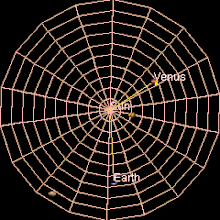مدار زهره

مدار زهره (انگلیسی: Orbit of Venus) زهره دارای مداری با محور نیمقطر بزرگ و نیمقطر کوچک ۰٫۷۲۳ یکای نجومی (۱۰۸٬۲۰۰٬۰۰۰ کیلومتر؛ ۶۷٬۲۰۰٬۰۰۰ مایل) و خروج از مرکز مداری ۷۰۰/۰ است[۱].[۲] گریز از مرکز اندک، به همراه اندازهٔ نسبتاً کوچک مدار آن، باعث میشود تا زهره، کمترین برد را در فاصلهٔ بین اوج و حضیض داشته باشد. این سیاره، هر ۲۲۵ روز یک بار به دور خورشید میچرخد و با انجام این کار، ۴٫۵۴ یکای نجومی (۶۷۹٬۰۰۰٬۰۰۰ کیلومتر؛ ۴۲۲٬۰۰۰٬۰۰۰ مایل) را طی میکند[۳]. سرعت مداری زهره برای پیمودن چنین فاصلهای، ۳۵ کیلومتر بر ثانیه (۷۸٬۰۰۰ مایل بر ساعت) است. زمانی که دستگاه مختصات دائرةالبروجی زهره با خورشید منطبق است، در مقارنه خورشید قرار میگیرد.[۴] فاصلهٔ میان زهره و زمین از حدود ۴۲ میلیون کیلومتر تا حدود ۲۵۸ میلیون کیلومتر، متغیر است.
تمام سیارات منظومه شمسی، در جهت خلاف عقربههای ساعت(نام علمی: anticlockwise direction) به دور خورشید میچرخند که از بالای قطب شمال زمین مشاهده میشود. بیشتر سیارات همچنین، روی محورهای خود در جهت خلاف عقربههای ساعت میچرخند، اما زهره در هر ۲۴۳ روز زمینی، یک بار واپسگرا (نام علمی: retrograde rotation) میچرخد که کندترین چرخش در میان همهٔ سیارهها است.[۵] زهره، هیچ قمر طبیعی ندارد[۶] هر چند، دارای چند تروجان است.[۷][۸]
منابع
[ویرایش]- ↑ Simon, J.L.; Bretagnon, P.; Chapront, J.; Chapront-Touzé, M.; Francou, G.; Laskar, J. (February 1994). "Numerical expressions for precession formulae and mean elements for the Moon and planets". Astronomy and Astrophysics. 282 (2): 663–683. Bibcode:1994A&A...282..663S.
- ↑ Jean Meeus, Astronomical Formulæ for Calculators, by Jean Meeus. (Richmond, VA: Willmann-Bell, 1988) 99. Elements by Simon Newcomb
- ↑ The sidereal and anomalistic years are both 224.7008 days long. The sidereal year is the time taken to revolve around the Sun relative to a fixed reference frame. More precisely, the sidereal year is one way to express the rate of change of the mean longitude at one instant, with respect to a fixed equinox. The calculation shows how long it would take for the longitude to make one revolution at the given rate. The anomalistic year is the time span between successive closest approaches to the Sun. This may be calculated in the same manner as the sidereal year, but the mean anomaly is used.
- ↑ Jean Meeus, Astronomical Algorithms (Richmond, VA: Willmann-Bell, 1998) 238. The formula by Ramanujan is accurate enough.
- ↑ "The length of a day on Venus is always changing – Space". EarthSky. 2021-05-05. Archived from the original on 28 April 2023. Retrieved 2023-04-28.
- ↑ Sheppard, Scott S.; Trujillo, Chadwick A. (July 2009). "A Survey for Satellites of Venus". Icarus. 202 (1): 12–16. arXiv:0906.2781. Bibcode:2009Icar..202...12S. doi:10.1016/j.icarus.2009.02.008. S2CID 15252548.
- ↑ Mikkola, S.; Brasser, R.; Wiegert, P.; Innanen, K. (July 2004). "Asteroid 2002 VE68: A Quasi-Satellite of Venus". Monthly Notices of the Royal Astronomical Society. 351 (3): L63. Bibcode:2004MNRAS.351L..63M. doi:10.1111/j.1365-2966.2004.07994.x.
- ↑ De la Fuente Marcos, Carlos; De la Fuente Marcos, Raúl (November 2012). "On the Dynamical Evolution of 2002 VE68". Monthly Notices of the Royal Astronomical Society. 427 (1): 728–39. arXiv:1208.4444. Bibcode:2012MNRAS.427..728D. doi:10.1111/j.1365-2966.2012.21936.x. S2CID 118535095.
- مشارکتکنندگان ویکیپدیا. «Orbit of Venus». در دانشنامهٔ ویکیپدیای انگلیسی، بازبینیشده در ۱۶ مارس ۲۰۲۴.
